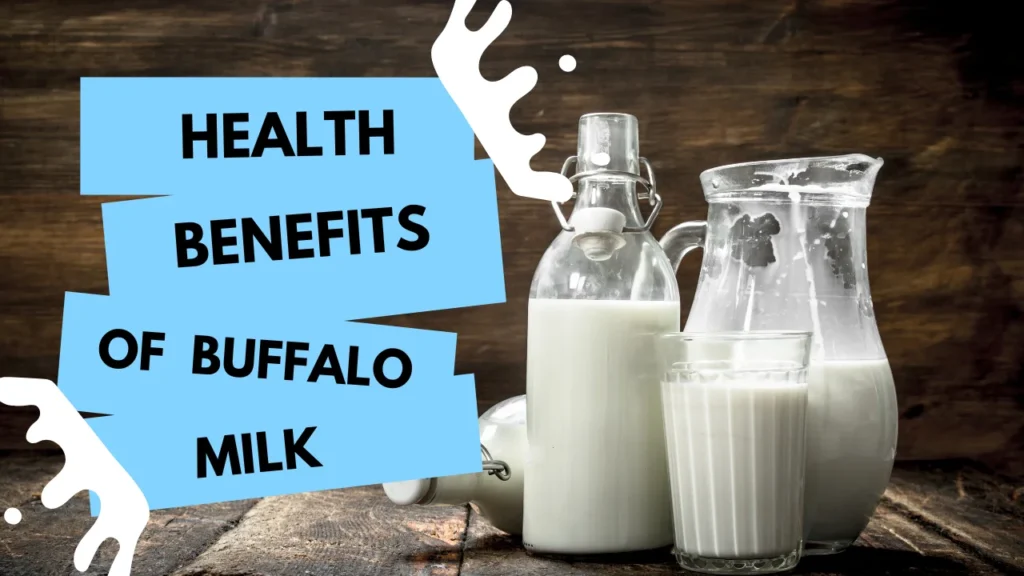Wellhealthorganic.com/Benefits-of-Buffalo-Milk

Buffalo milk is highly valued across the globe, particularly in regions like South Asia, the Middle East, and parts of Europe. Its thicker and creamier consistency stems from its higher fat and protein content compared to cow milk, making it an excellent base for rich dairy products. Its nutritional superiority lies in its higher levels of calcium, magnesium, and iron, essential for strong bones, better oxygen transport, and overall health. This milk is also a preferred choice in both traditional and modern recipes due to its adaptability.
In traditional diets, buffalo milk is a key ingredient in producing items like clarified butter (ghee), thick yogurts, and cheeses such as mozzarella, highly popular in Italian cuisine. In desserts, its creamy texture enhances the richness of kheer, halva, and ice creams like kulfi. For modern diets, buffalo milk aligns well with high-protein or ketogenic meal plans, as its fat and protein content provides sustained energy and satiety.
What Makes Buffalo Milk Unique?
Buffalo milk stands out for its rich nutritional content, creamy texture, and distinctive flavor. Compared to cow milk, buffalo milk contains higher levels of protein, fat, calcium, and phosphorus, making it a more nutrient-dense option. Its thicker consistency is due to larger fat globules, which also contribute to its rich taste and suitability for dairy products like cheese, butter, and yogurt. Unlike cow milk, buffalo milk has a lower cholesterol content, making it heart-friendly while still being energy-rich. Its antioxidant properties and slower digestion rate provide prolonged energy, which is especially beneficial for active individuals or those recovering from illness. Additionally, buffalo milk has a longer shelf life due to its higher peroxidase activity, making it less prone to spoilage. These qualities make buffalo milk a preferred choice for both traditional and modern recipes, enhancing its appeal across diverse dietary practices.

Why Buffalo Milk Stands Out
The primary reason buffalo milk garners attention is its high nutritional value. It has about 50% more fat than cow milk, making it a great energy source. The higher protein levels are crucial for muscle building and repair. Additionally, the fat globules in buffalo milk are larger, contributing to its rich, creamy texture, which is especially valued in making dairy products like butter and cheese. Moreover, buffalo milk contains lower cholesterol levels, making it a heart-healthy option for individuals concerned about cardiovascular health.
Health Benefits of Buffalo Milk
Buffalo milk is known for its exceptional health benefits. It contains a significant amount of calcium, magnesium, and phosphorus, all of which are crucial for maintaining strong bones and teeth. This is why it is particularly recommended for children, pregnant women, and the elderly. The vitamins A, D, and B12 in buffalo milk enhance immune system functionality and overall well-being. Its higher iron content compared to cow milk makes it an excellent choice for individuals prone to anemia.
One remarkable property of buffalo milk is its antioxidant content, which helps combat free radicals in the body, reducing oxidative stress and promoting skin health. Additionally, the casein protein in buffalo milk has slower digestion rates, making it ideal for prolonged energy release, especially for athletes or individuals with demanding physical routines.
Buffalo Milk in Culinary Traditions
Buffalo milk is widely used to make mozzarella cheese, a staple in Italian cuisine. Its creaminess is also perfect for making yogurt, butter, and clarified butter (ghee). In South Asian households, buffalo milk is the base for rich desserts like kheer (a milk-based pudding) and gulab jamun (milk-solid-based sweets). Due to its creamy texture, it is preferred for making kulfi, a traditional Indian ice cream.
For coffee enthusiasts, buffalo milk offers a richer texture and taste compared to cow milk, enhancing the overall experience of lattes or cappuccinos.
Comparison with Cow Milk
| Aspect | Buffalo Milk | Cow Milk |
|---|---|---|
| Fat Content | Higher (6.9%) | Lower (3.4%) |
| Protein Content | Higher (4.5 g/100 ml) | Lower (3.2 g/100 ml) |
| Calories | 97 kcal/100 ml | 61 kcal/100 ml |
| Calcium Content | Higher (195 mg/100 ml) | Lower (120 mg/100 ml) |
| Cholesterol | Lower | Higher |
Buffalo milk is richer in calories, making it a preferred choice for growing children and individuals needing high-energy diets. However, individuals aiming for weight control or low-fat diets might prefer cow milk.
Also Read: Sheera Recipe Guide: Sweet Delight for Any Occasion
Potential Drawbacks
Despite its benefits, buffalo milk is not suitable for everyone. Due to its higher fat and calorie content, it might not align with the dietary needs of those aiming to reduce fat intake or control their weight. It can also be harder to digest for individuals who are lactose intolerant or have sensitive stomachs. The creamy texture, while desirable for some, can be overwhelming for others in its natural form.
Environmental and Economic Factors
Buffaloes are more adaptable to hot and humid climates, making their milk production more viable in tropical and subtropical regions. Buffalo milk production is also environmentally sustainable because buffaloes consume roughage that would otherwise go to waste.
Economically, buffalo milk is a vital part of rural livelihoods in countries like India, Pakistan, and Nepal, where it supports millions of families. The demand for buffalo milk and related products like ghee and mozzarella contributes significantly to the dairy industry’s growth in these regions.
Also Read: Home Remedies WellHealthOrganic: Natural Solutions for Everyday Health
Incorporating Buffalo Milk into a Balanced Diet
Buffalo milk can be consumed as a standalone beverage or used in a variety of recipes. For individuals looking to add muscle mass or recover from physical activities, its high protein and energy content make it a great post-workout drink. Adding it to smoothies or breakfast cereals enhances their nutritional value.
For weight management, consider using toned or double-toned buffalo milk, which has reduced fat content while retaining most of the essential nutrients.
Also Read: Beauty Glazed Eyeshadow Palette: Known For Its Beauty Mystery
Storage and Shelf Life
Buffalo milk has a longer shelf life due to its higher peroxidase activity, making it less prone to spoilage compared to cow milk. However, it still needs to be stored in a cool environment to maintain freshness.
Cultural Significance of Buffalo Milk
In many cultures, buffalo milk holds ceremonial importance. In India, it is often used in religious rituals and offerings due to its purity. The milk is also a symbol of prosperity in rural areas, where owning buffaloes signifies wealth and status.
Also Read: Wellhealthorganic.com : Buffalo Milk Good for Health
Future of Buffalo Milk
The increasing awareness about the health benefits of buffalo milk, combined with advancements in dairy processing, is likely to boost its demand globally. Innovations like low-fat buffalo milk and lactose-free buffalo milk products are paving the way for its broader acceptance.
The future of buffalo milk looks promising as the global focus on nutrition and sustainability grows. With the increasing demand for nutrient-rich dairy products, buffalo milk is gaining recognition beyond traditional markets like South Asia, Italy, and the Middle East. Its high protein, calcium, and fat content, along with its lower cholesterol levels compared to cow milk, make it an attractive option for health-conscious consumers worldwide.
Who Should Consume Buffalo Milk?
Buffalo milk is ideal for individuals of all ages due to its rich nutritional profile. It is especially recommended for children, pregnant women, and the elderly because of its high calcium and vitamin content, which support bone health, growth, and development. Athletes and bodybuilders can benefit from its high protein content, aiding muscle repair and recovery. Those with anemia or iron deficiencies may find buffalo milk helpful, as it contains more iron compared to cow milk. People seeking natural energy sources or trying to gain weight can also benefit from its high caloric and fat content.
Also Read: Wellhealthorganic Buffalo Milk Tag: Benefits and Uses
However, individuals with lactose intolerance or milk allergies should avoid buffalo milk or opt for lactose-free versions. For those on calorie-restricted diets, reduced-fat buffalo milk offers a healthier alternative without compromising on essential nutrients. Its low cholesterol levels make it a suitable choice for those monitoring heart health. Ultimately, buffalo milk is versatile, catering to diverse dietary needs while providing a wholesome and flavorful addition to meals.
Conclusion
Buffalo milk, with its rich texture and dense nutritional profile, is undoubtedly a powerhouse of health benefits. Whether consumed for its creamy taste, used in traditional recipes, or appreciated for its health advantages, buffalo milk is a versatile dairy option. As highlighted in wellhealthorganic.com/benefits-of-buffalo-milk, it is essential to include such nutrient-rich options in your diet, provided they align with your health goals and dietary preferences.
Also Read: Wellhealthorganic.com/Vitamin-e-Health-Benefits-And-Nutritional-Sources






